Proven Cycling Tips: 13 to Conquer Traffic, & Conditions
I love urban cycling; yet the task of getting around in a congested area becomes very common especially here in Florida. Now everything is a strategy and mindset, but not a risk and everyone can apply these cycling solutions to their day to day. I’ll tell you how to confidently tackle the biggest bike commuting challenges that works for cyclists of all experience levels.
Something I notice is when I get out on a rainy day, wearing heavier clothes such as jeans or sweatpants is not going to fair well once they get wet.
When it rained this day, I decided to wear a jacket that didn’t soak through my clothes with this ride-share bike.
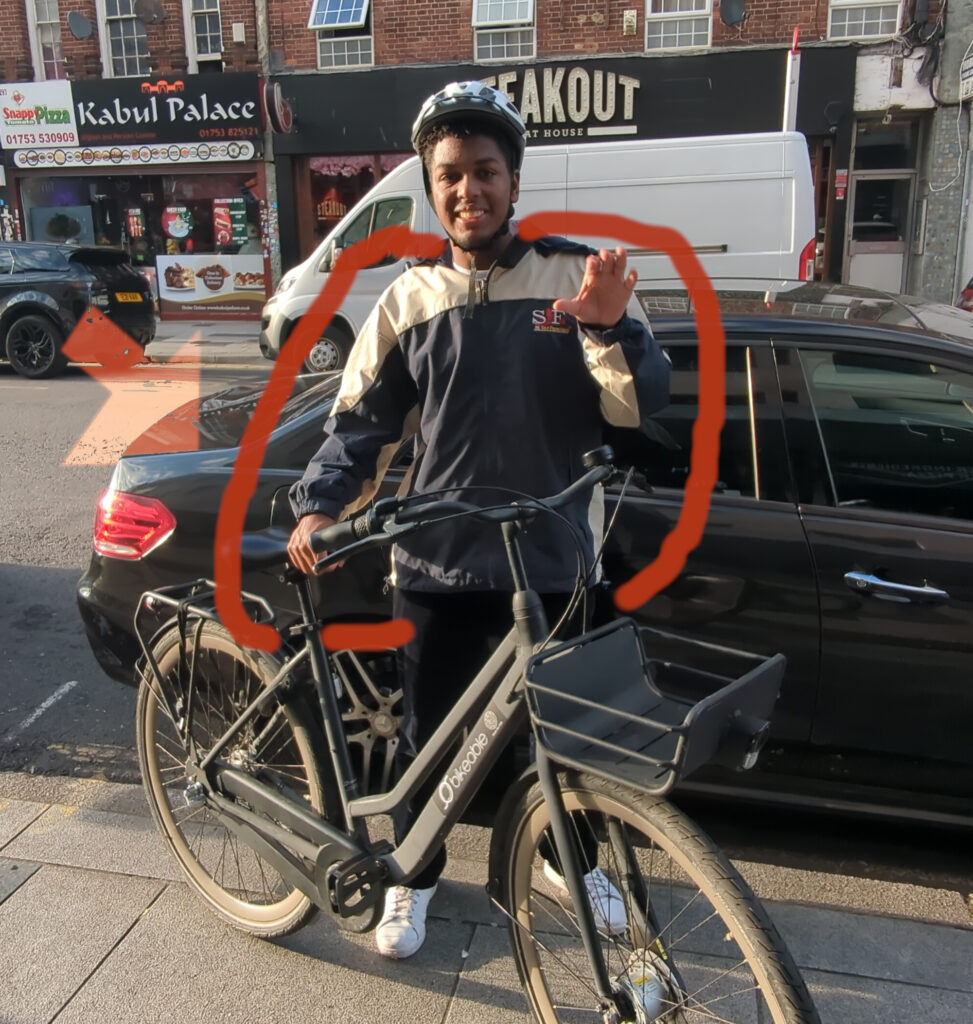
Navigating Traffic Safely
Let’s be real, cycling alongside cars can be downright terrifying when you’re new to it. I spent my first year exclusively riding on sidewalks because I was too scared to share the road with vehicles. Looking back then, I wasn’t doing myself any favors. Sidewalks have their own hazards, pedestrians, driveways, and uneven surfaces in many places plus I’m not sure if you know but in most cities plus Canada riding on the sidewalk is illegal. Obviously against the whole concept of urban cycling.
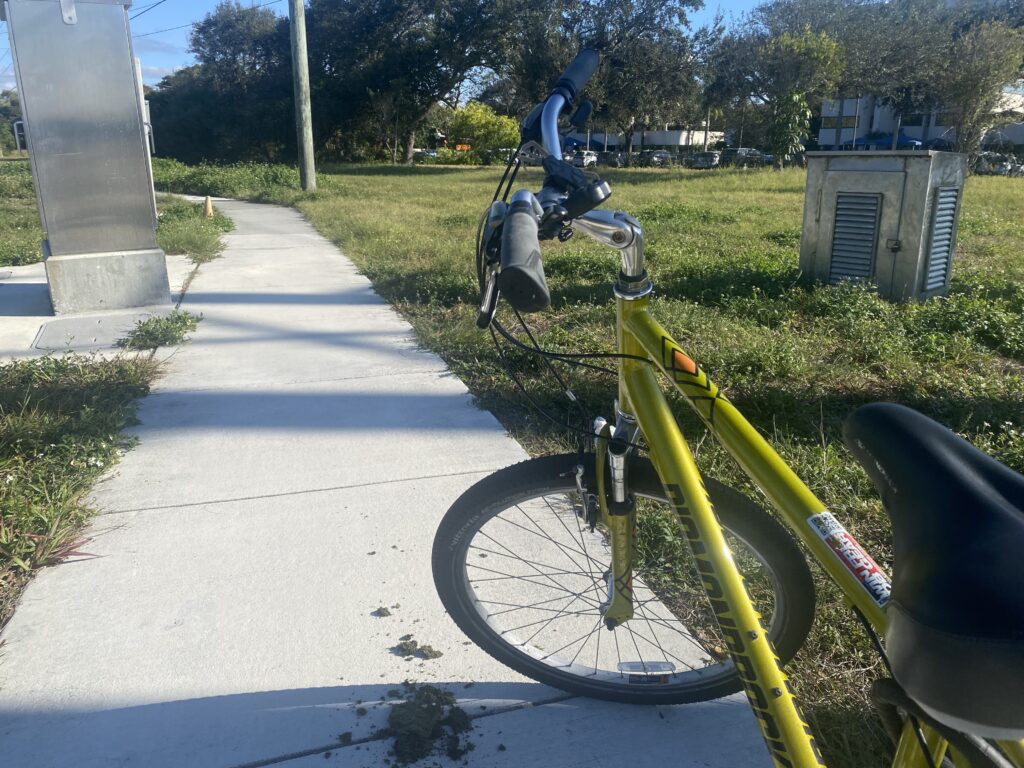
The biggest game-changer for me was learning to think like traffic, not just exist in it. Cars are predictable when you understand the patterns. They stop at red lights, slow down at intersections, and easy to anticipate, even the terrible ones I promise you. Once I figured that out, I could anticipate their movements instead of just reacting to them.
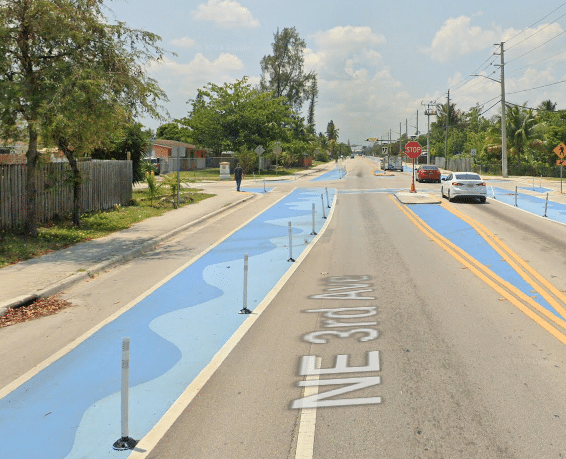
When it comes to bike lanes, not all are created equal. Some are beautifully protected with barriers, while others are just sad little painted lines that cars regularly cross. Barrier bike lanes will almost always be comfortable but lanes with bike is discretionary on your comfort-ability, one thing I will recommend or note is the wide ones such as in the picture will generally be fine to bike on as long as the road is 35 miles per hour or less.
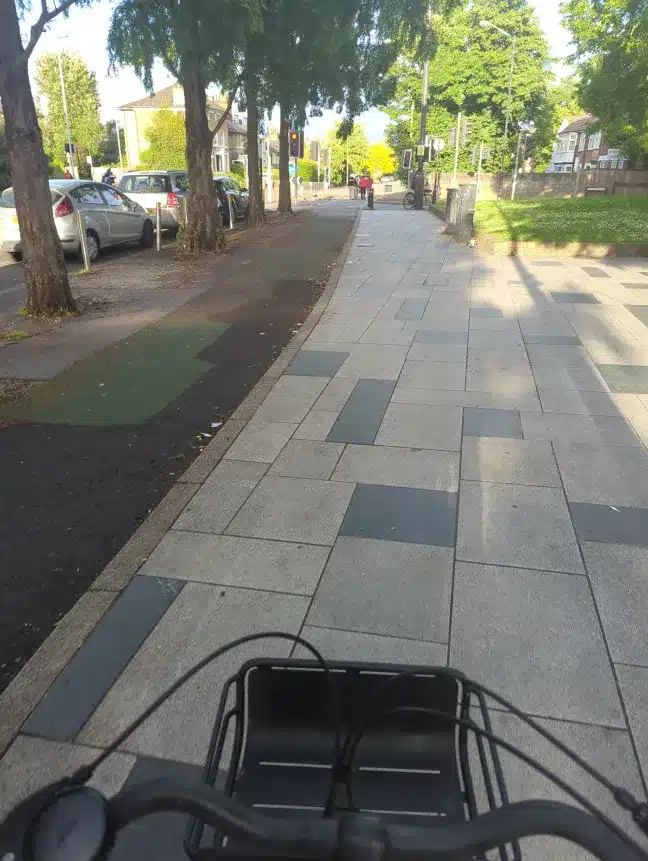
One mistake I made early on was picking the shortest route rather than the safest one. These days, I’ll happily add an extra mile to my commute if it means traveling on roads with less traffic or better infrastructure. Trust me, your peace of mind is worth those extra minutes.
Intersections are the most important thing to pay attention to, it’s the reason why I always use bike apps such as Strava, or Maps for IPhone, (best general maps app for bikers.) They’re where about 75% of bike-vehicle collisions happen, according to safety studies I’ve read. I’ve developed this habit of making eye contact with drivers whenever possible. It’s amazing how much safer you feel when you know they’ve actually seen you.
Weather conditions can throw a major wrench in even the most careful cycling plans. I once tried riding through a thunderstorm (not my brightest moment) and learned the hard way that visibility works both ways – I couldn’t see well, and drivers definitely couldn’t see me. Now I check the forecast religiously before heading out.
Nighttime riding requires extra precautions. I invested in some serious lighting equipment after a close call at dusk. Front light, back light, spoke lights, reflective vest – I probably look like a rolling Christmas tree, but better safe than sorry! The difference in how drivers respond to you when you’re properly lit up is night and day. Literally.

The most valuable skill I’ve developed is route planning. I spend time studying maps, trying different paths, and mentally noting hazards along each route. Understanding traffic flow has transformed my daily rides from stress-inducing adventures into actually enjoyable experiences. Some streets are just naturally more bike-friendly, with lower speeds, fewer cars, or more attentive drivers.
What about you? Have you found your comfort zone with traffic yet? Remember, there’s no shame in taking it slow and building confidence gradually. We all started somewhere, and getting home safely matters more than looking like a pro cyclist. Stay safe out there.
Mastering Weather Conditions
I used to be what you’d call a “light weather cyclist.” If there was even a hint of rain in the forecast, my bike would stay and I’d become a driver once again. Now the first semester of my college, my car was inconsistently working for months and months straight, and I had no choice but to bike to college and work everyday, regardless of what Mother Nature had planned. It wasn’t just an experience it was education.
That first rainy commute was miserable. I showed up at school with my jeans soaked, hours after showered at work my shoes squeaked all day, and I’m pretty sure I had a couple people point it out. Not my finest moment, for sure. But it taught me a valuable lesson, with the right gear and mindset, any weather can be biking weather.
When the mercury rises, I’ve learned the magic of starting early. A 6 AM ride feels drastically different from a noon ride in July. The streets are quieter, the air is cooler, and the sun isn’t trying to cook you alive. Plus, there’s something peaceful about watching the world wake up from the seat of your bike.
Fabric choice makes a world of difference in hot weather. I used to wear my regular cotton t-shirts until I discovered the miracle of moisture-light materials, ever heard of dry-fit? I actually forgot because of the convenience of are a regular shirt. Now my summer cycling wardrobe consists of lightweight, breathable shirts that don’t cling to me like a second skin when I sweat. Game-changer!

Rainy days required the biggest adjustment to my cycling mindset. A good rain jacket and pants changed everything for me. The first time I arrived dry despite pouring rain, I felt like I’d discovered some kind of superpower. Fenders were another revelation – keeping that streak of dirty water off my back makes rainy rides so much more bearable.
The biggest mistake I see new all-weather cyclists make is overdressing. I did this too! You should feel slightly cool when you first start pedaling because you’ll warm up quickly. If you’re comfortable standing still, you’ll be overheating five minutes into your ride. I’ve learned this the hard way more times than I’d like to admit, trust me I do that way too many times when it comes to the rain and I’ve only started to get better at it.
Wind might be the most underrated weather challenge. I once got caught in a 30 mph crosswind that nearly blew me into traffic. Scary stuff! Now I check wind forecasts as carefully as I check for rain. On super windy days, I adjust my route to use streets with more buildings or trees for wind protection.
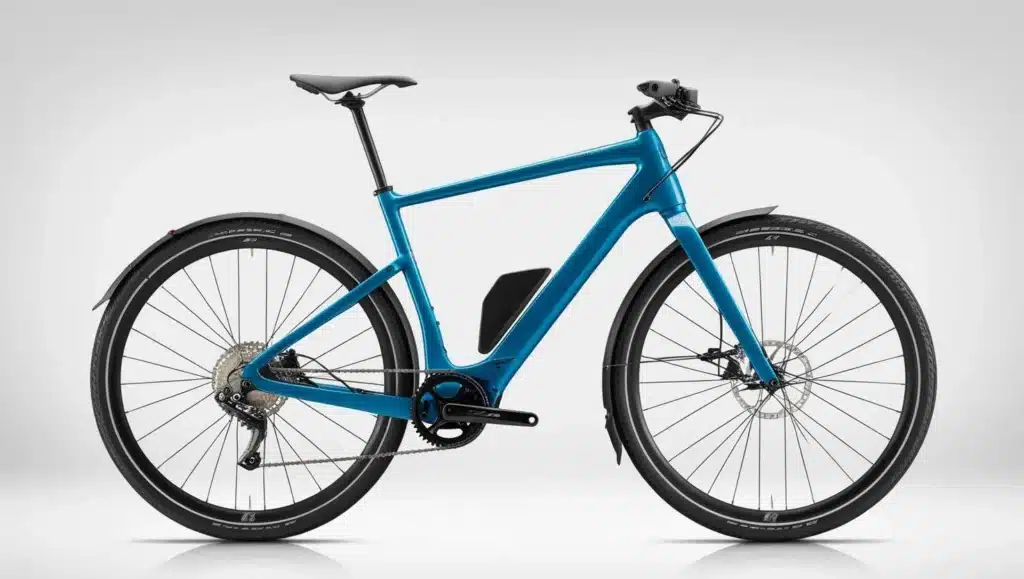
Ultimately, mastering different weather conditions has made me a stronger, more confident cyclist. Each season offers its own unique riding experience, and there’s something satisfying about conquering the elements instead of hiding from them. With the right preparation, your cycling doesn’t have to take a season off – and neither do the physical and mental benefits that come with it!
Solving the Parking Puzzle
I used to think car drivers had it rough with parking until I moved downtown with my beloved road bike. On my very first day, I came back from a coffee run to find my bike seat missing! Left the frame locked to a street sign but completely forgot about the quick-release seat. Rookie mistake that cost me eighty bucks and taught me my first hard lesson about bike parking in the city.
Figuring out where and how to park your bike might seem like a minor concern, but trust me, it can make or break your cycling lifestyle. After five years of daily urban riding, I’ve had my fair share of parking mishaps and victories. That time I found my handlebars turned into a makeshift trash can? Not great. The day I discovered my building’s hidden secure bike room? Total game-changer.
Bike racks come in all shapes and sizes, and not all are created equal. Those artistic-looking racks shaped like bicycles? Often terrible for actually securing a bike properly. I learned to look for sturdy, anchored racks that allow you to lock both your frame and wheel with a U-lock. The Sheffield rack (looks like an upside-down U) remains the gold standard for a reason.
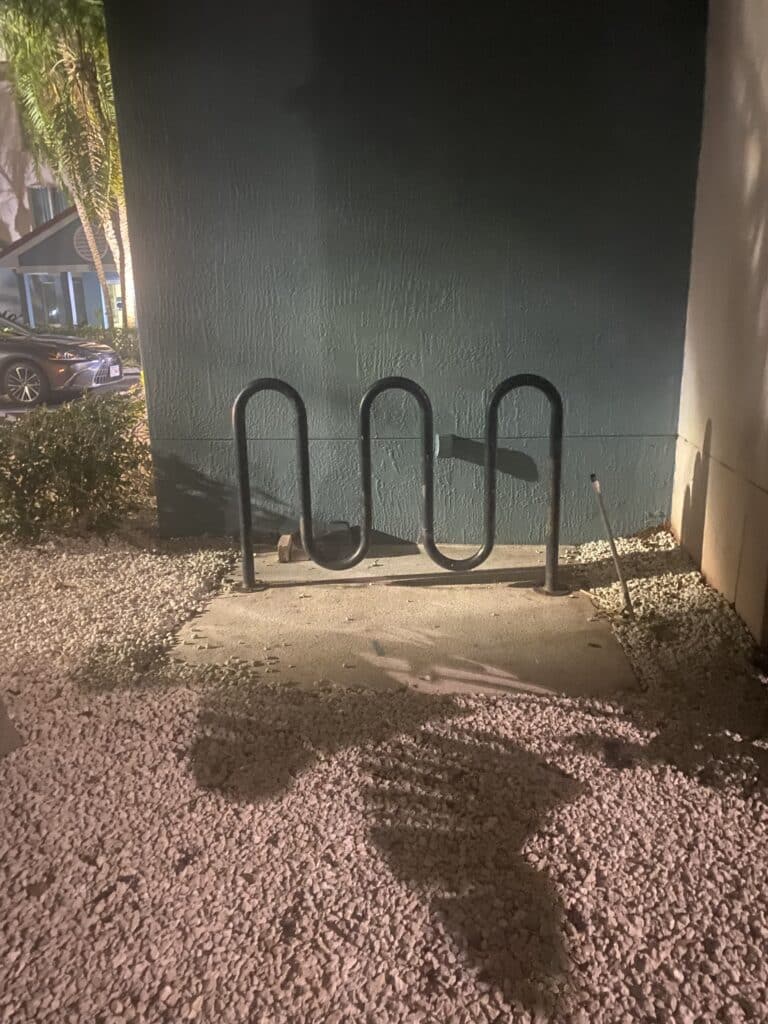
For years, I just carried a single cable lock and thought I was being smart. Then my neighbor’s bike disappeared despite being “locked” with the same setup. Now I follow the 10% rule – spend at least 10% of your bike’s value on locks. For my $800 commuter, that means about $80 worth of security, which I split between a solid U-lock and a supplementary chain.
Weather exposure is something car drivers rarely worry about, but it can wreak havoc on a bicycle. After leaving my bike out during a week of rain and finding a rusty chain and squeaky brakes, I started seeking covered parking options. Many office buildings have dedicated covered bike areas if you just ask the right person. My building manager had no idea I was interested until I mentioned it!
Some of my most creative parking solutions have come from necessity. When visiting a friend’s fifth-floor walk up with no outdoor racks nearby, I was stumped until she showed me how she hangs her bike on wall hooks in her entryway. Since then, I’ve installed similar hooks in my apartment, turning my bike into functional wall art when not in use.
Security goes beyond just where and how you lock up. I’ve started removing accessories like lights, computers, and panniers when parking in public. After losing two lights and a handlebar bag, I finally wised up. It takes an extra minute, but beats spending money replacing stuff constantly.
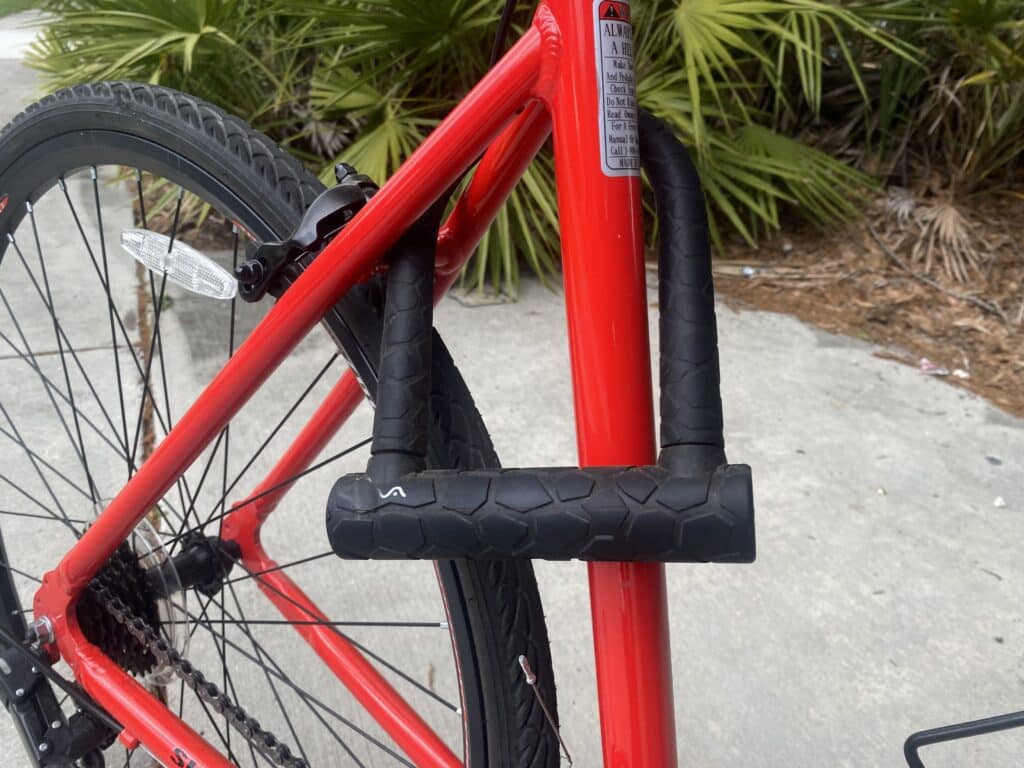
One thing that caught me by surprise was how different parking needs can be depending on duration. For quick errands under 15 minutes, I might use a simple lamp post with good visibility. For work days, I need something more secure and weather-protected. And for overnight parking? That’s when I absolutely won’t compromise on bringing my bike inside.
If your workplace lacks good bike parking, speak up! I helped convince my previous employer to convert an unused storage closet into a bike room by showing them the cost-benefit analysis. More employees could commute by bike, reducing parking pressure for cars and promoting healthier staff. They actually thanked me for the suggestion!
The beauty of cycling is that parking stress – that endless circling the block looking for a spot – becomes practically non-existent. Even in the most congested urban areas, I can nearly always find a place to lock up within a few feet of my destination. That freedom alone makes all the occasional parking hassles worthwhile. Once you’ve mastered the basics of secure locking and identified your regular parking spots, you’ll wonder how you ever tolerated car parking in the first place!
Essential Safety Strategies
I still get a pit in my stomach thinking about my first close call in downtown traffic. A taxi swung right into the bike lane without looking, missing me by inches. I was doing everything by the book – helmet on, riding in the designated lane, following traffic signals. But that day taught me that knowing basic rules isn’t enough. There’s a whole other level to urban cycling safety that nobody had ever explained to me.
After that scare, I became obsessed with learning what experienced city cyclists knew that I didn’t. Turns out, there’s a whole arsenal of specific techniques beyond just “follow traffic laws” that dramatically improve your safety margins. These strategies have transformed my daily commute from nerve-wracking to actually enjoyable.
Visibility isn’t just about having lights (though those are non-negotiable). I learned that how you position yourself in the lane makes a huge difference in whether drivers actually see you. Riding too close to parked cars not only puts you in door zone danger, but it makes you practically invisible to traffic. Now I ride about a third of the way into the lane when there’s no bike lane available. Yes, occasionally someone honks, but I’d rather be honked at than hit!
The concept of “taking the lane” was revolutionary for me. I used to hug the curb, trying to stay out of everyone’s way. Big mistake! This actually encourages drivers to squeeze past you with inches to spare. Now on narrow streets, I temporarily claim the entire lane when it’s unsafe for a car to pass. Once there’s room, I move back over to let traffic flow. Most drivers respect this approach once they understand what you’re doing.
Hand signals were something I initially felt dorky using. Who was I, some cycling referee? But the first time I clearly signaled a left turn and watched a driver actually slow down to let me merge, I was converted. Now I signal everything – turns, lane changes, even pointing out potholes to cyclists behind me. Clear communication eliminates so much risk.
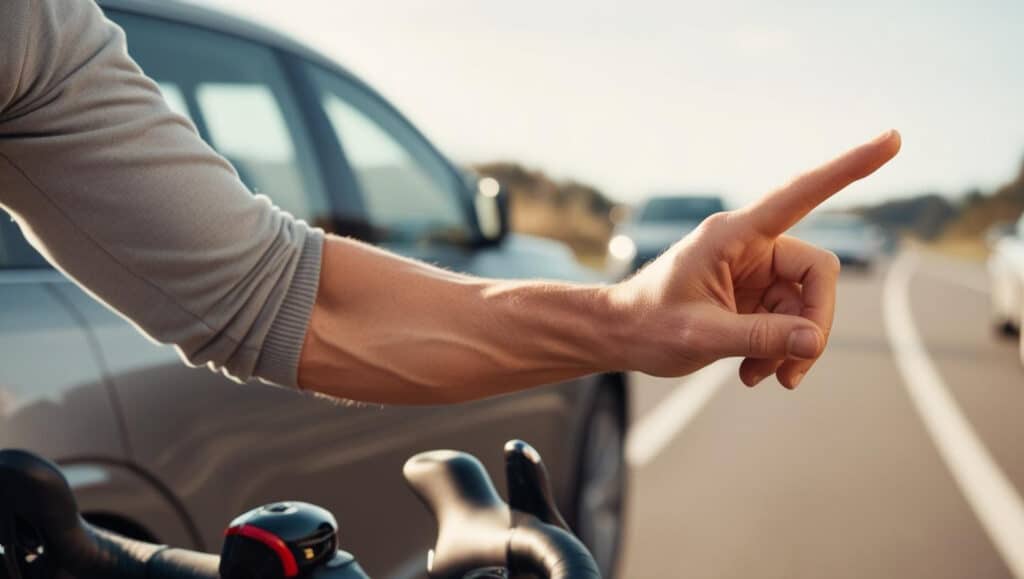
Eye contact is something I practice religiously at intersections. I literally won’t proceed until I’ve made eye contact with waiting drivers. It sounds simple, but it’s shocking how often a driver will look right through you until you catch their gaze. Then there’s that little nod that says, “Yes, I see you exist.” That moment of connection has prevented countless potential conflicts.
The door zone – that 3-4 foot space next to parked cars – claimed my colleague’s collarbone last year. She was riding properly in the bike lane, but it ran right alongside parking. Someone flung their door open without looking and sent her flying. Now I treat parked cars like they’re a foot wider than they actually are, even if it means temporarily leaving the bike lane.
Intersection strategy was something I had to completely relearn. I used to hang back behind cars, thinking I was being cautious. Actually, I was making myself invisible. Now at red lights, I position myself either directly in front of a car where they can see me (when going straight) or in the center of the lane (when turning). Being seen is your biggest safety tool.
Weather affects safety strategy more than I initially realized. After wiping out on wet leaves one autumn morning, I’ve learned to adjust both my route and riding style seasonally. No more sharp turns on rainy days, and I add extra distance between myself and vehicles since both our stopping distances are longer.
The most counter intuitive safety lesson I’ve learned is that hesitation often creates more danger than confident movement. When I first started, I’d second-guess myself constantly – pausing mid-intersection, yielding when I had right-of-way, making unpredictable stops. Now I move with intention and predictability, which actually makes drivers more comfortable around me.
Looking back at my early riding days, I’m amazed I survived with such a limited safety toolkit. There’s really an art to urban cycling that goes far beyond rules and gear. What safety strategies have made the biggest difference in your city riding experience? I’m always looking to add new techniques to my safety arsenal!
Route Planning Mastery
The day I stopped following Google’s default bike directions was the day my urban cycling experience completely transformed. I’ll never forget huffing and puffing up that massive hill on 4th Avenue, cars whizzing by inches from my elbow, thinking “there’s got to be a better way.” Turns out, there absolutely was—just two blocks over ran a quiet neighborhood greenway with gentle grades and barely any traffic. That discovery kicked off my obsession with mastering the art of route planning.
When I first started bike commuting, I made the classic rookie mistake of thinking the shortest route was automatically the best. Man, was I wrong! That “direct” route had me battling bus traffic, navigating pothole-riddled roads, and dealing with aggressive drivers at poorly designed intersections. The stress would have me arriving at work with white knuckles and a racing heart—not exactly the energizing morning exercise I was hoping for.
These days, my approach to route planning is completely different. I’ve learned that a slightly longer route on calm streets isn’t just more pleasant—it’s often actually faster than fighting through congested arterials. Plus, I arrive at my destination feeling refreshed rather than relieved to have survived.
Modern mapping tools have seriously upped my route-planning game. I ditched regular Google Maps for cycling-specific apps that include user-generated ratings for streets and bike infrastructure. Game-changer! These tools show me things like steepness of hills (my nemesis), quality of pavement, and—most importantly—streets that local cyclists have identified as bike-friendly.
The coolest thing I’ve discovered is the “quiet street network” that exists in almost every city. These are residential roads, often with traffic calming features like speed bumps or diverters, that create perfect corridors for cycling while remaining practically hidden to most drivers. My current commute follows these secret passages for about 80% of the journey, and the difference in stress level is night and day.
Learning to read traffic patterns transformed my route selection process. I noticed that certain routes might be pleasant at 10 AM but absolute nightmares during rush hour. Through trial and error (and yes, some white-knuckle experiences), I’ve mapped out time-specific routes. My morning commute actually differs from my evening return trip to account for traffic flow changes—sounds complicated, but it’s become second nature.
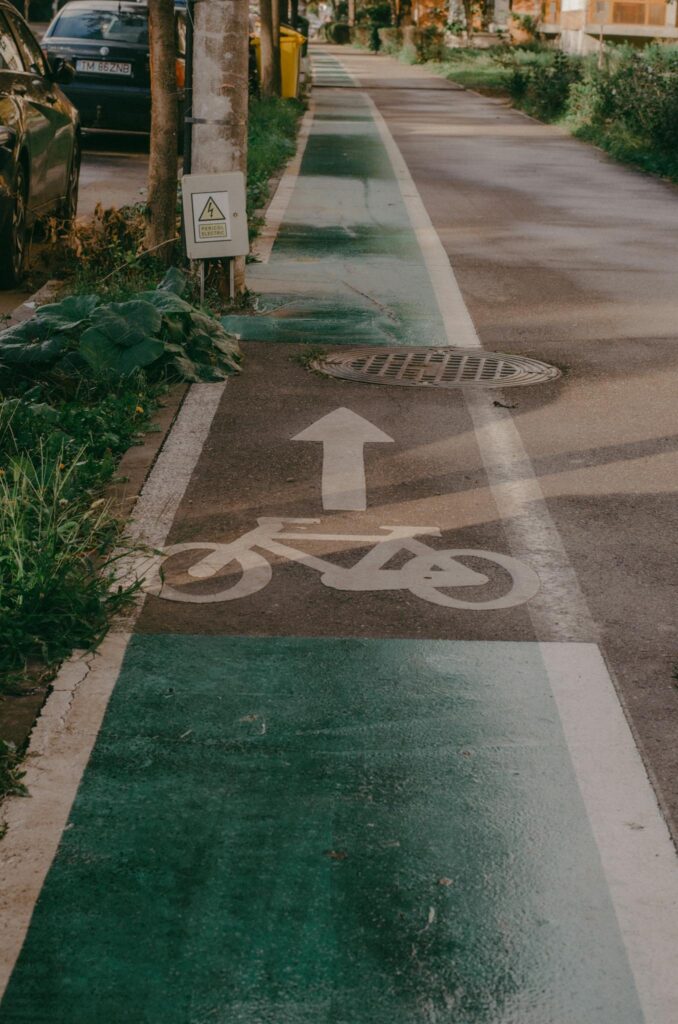
Weather considerations factor heavily into my route decisions now. After getting completely drenched riding through an underpass that floods during heavy rain, I developed rainy day alternatives. Similarly, I have shaded summer routes and sheltered winter options. Having these seasonal variations ready to go means weather rarely keeps me off my bike anymore.
One thing that took me way too long to figure out was the value of local cycling knowledge. When I finally joined a community bike ride, the route insights I gained in one afternoon surpassed months of solo exploration. Experienced local cyclists know which pedestrian bridges allow bikes, which parks have paved paths, and which scary-looking industrial areas actually have the smoothest, quietest riding in town.
The most unexpected benefit of route mastery has been discovering my city in an entirely new way. I’ve found hidden parks, quirky local businesses, gorgeous viewpoints, and peaceful corridors I never would have encountered in a car. My mental map of the city has expanded beyond main roads to include this rich network of backstreets and passages that make it feel like a different place entirely.
For anyone looking to level up their cycling experience, I can’t emphasize enough how transformative thoughtful route planning can be. It’s the difference between white-knuckling through traffic and actually enjoying the journey. What started as a stress-reduction strategy has become something I genuinely look forward to each day. The extra five minutes I spend might add a quarter-mile to my trip, but the reduction in stress and increase in enjoyment is absolutely priceless.
Gear and Equipment Solutions
When I first started cycling regularly, I thought I needed to drop a small fortune on fancy gear before I could really enjoy riding. My first bike shop visit was overwhelming—the salesperson kept throwing around terms like “pannier systems” and “Gore-Tex membranes” while I nodded along, completely lost and watching the potential cost climb astronomically. I left empty-handed and discouraged.
Fast forward through a few years of trial and error, and I’ve discovered something that would have saved me a lot of stress: most cycling challenges can be solved with surprisingly simple, affordable gear solutions. You don’t need to look like you’re competing in the Tour de France to have a comfortable, practical ride!
Take rain, for instance. My first rainy commute was a disaster—I arrived at work looking like I’d gone swimming in my clothes. After experimenting with expensive cycling-specific rain gear, I discovered that a basic waterproof jacket and pants from my local outdoor store worked just as well at a fraction of the price. The game-changer was adding inexpensive fenders to my bike. Twenty bucks and a 15-minute installation completely eliminated that dreaded stripe of dirty water up my back.
Carrying stuff used to be my biggest headache. I started with a backpack, which left me with a sweaty back and sore shoulders. I was convinced I needed fancy panniers, until a more experienced cyclist friend showed me her simple solution: a rear rack with folding baskets that cost less than dinner for two. Those baskets hold my groceries, work stuff, and even awkward-shaped packages without issue.
Night riding seemed scary until I invested in proper lights. This is one area where I don’t recommend skimping—a bright headlight and taillight are absolutely essential. But you don’t need to spend hundreds. I found a rechargeable set for about $40 that’s been going strong for years. The confidence of being well-lit transformed my winter commuting experience when darkness falls at 4:30 PM.
Cold weather initially kept me off my bike entirely. I thought I needed specialized cycling winter wear that would cost more than my bike itself! The reality? Layering clothing I already owned worked perfectly fine. A moisture-wicking base layer, warm mid-layer, and wind-resistant outer layer keep me comfortable down to freezing temperatures. My splurge was good gloves—frozen fingers are miserable and potentially dangerous when you need to brake quickly.
For hot weather, I wasted money on multiple “technical” cycling jerseys before realizing that lightweight, loose-fitting athletic shirts I already owned worked just as well.

Phone mounts caused me endless frustration until I found a simple silicone strap mount for about $15. It holds my phone securely for navigation and takes seconds to attach or remove when I reach my destination. No more stopping every few blocks to pull out my phone and check directions!
Storage solutions for my apartment seemed like they’d require expensive wall-mounting systems or floor stands. Then my neighbor showed me how two simple hooks in the wall let him hang his bike vertically, taking up minimal space. Total cost: under $10 and it actually looks pretty cool, like functional wall art.
The biggest lesson I’ve learned about cycling gear is that function trumps form every time. While those matching lycra outfits look professional, my collection of practical pieces from various sources serves me perfectly well. I’ve gradually upgraded certain items as they’ve worn out, but my initial bare-bones setup got me through thousands of miles comfortably.
So before you max out your credit card at the bike shop, start with the essentials and add pieces as you discover your actual needs through experience. That approach has saved me hundreds of dollars and helped me realize that the best gear solutions are often the simplest ones. The freedom of cycling shouldn’t come with financial stress—after all, one of the best things about bikes is how affordable they are compared to cars!
Building Confidence Gradually
My first attempt at city cycling was a complete disaster. I’d somehow convinced myself I could handle downtown traffic during rush hour on day one. Thirty minutes in, I was huddled on a bench in a cold sweat, calling my roommate for a rescue. Talk about diving into the deep end! Looking back, I can laugh at my overconfidence, but at the time I seriously considered selling my bike and never trying again.
That humbling experience taught me something crucial – urban cycling isn’t an all-or-nothing skill. It’s more like learning to swim. You don’t start in the ocean during a storm; you begin in the shallow end of the pool. After my initial failure, I took a huge step back and created a gradual confidence-building plan that completely transformed my cycling journey.
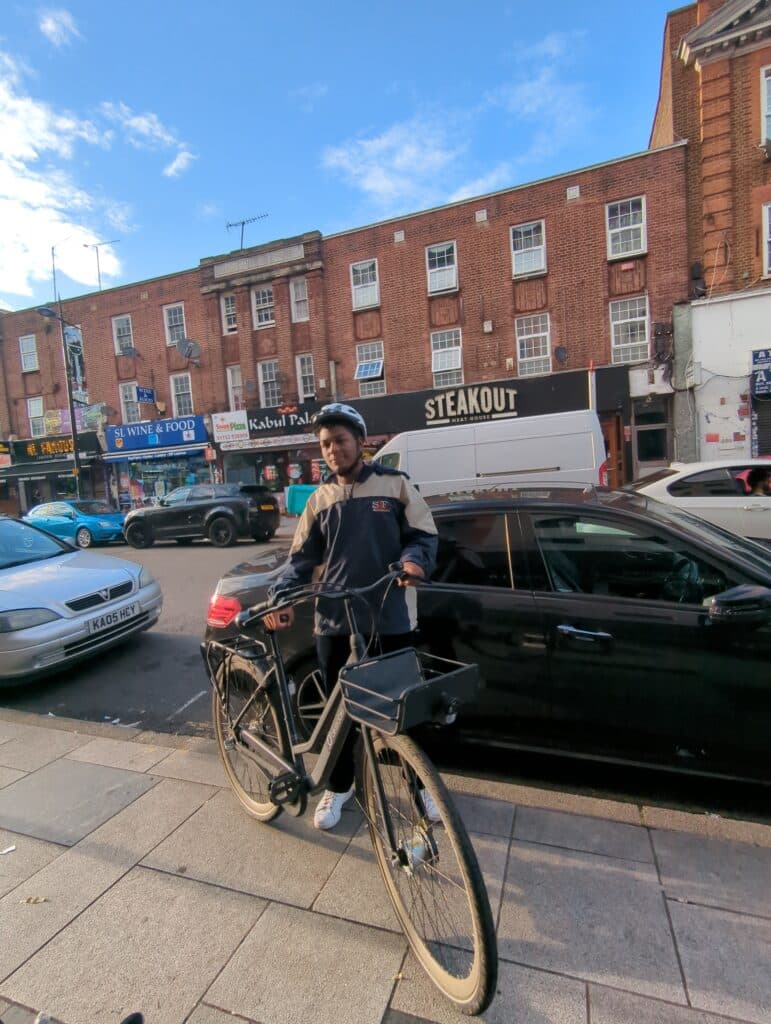
I started by mapping out the quietest residential streets in my neighborhood and practiced there during weekend mornings when traffic was practically non-existent. No pressure, no stress, just getting comfortable with the bike itself. Those peaceful rides helped me develop my basic handling skills without worrying about cars zooming past.
The next phase was venturing onto streets with bike lanes, but still during off-peak hours. I’ll never forget the first time I successfully navigated a four-way stop with other vehicles present. It seems so minor now, but at the time it felt like summiting Everest! Those small victories built my confidence bit by bit.
One thing that really helped was finding a slightly more experienced cycling buddy. My coworker Sarah had been commuting by bike for about a year, and she offered to ride with me on a quiet Sunday to show me her route. Having someone point out specific techniques – like where to position myself at intersections or how to signal effectively – made abstract concepts suddenly click. Plus, following her wheel gave me a concrete example of confident cycling in action.
Gradually increasing distance and complexity worked wonders. I started with a simple two-mile loop, then expanded to five miles that included one major intersection. Each successful ride proved to my anxious brain that yes, I could actually do this. The mental hurdles were honestly bigger than the physical ones.
Weather conditions became my next confidence-building tool. I initially only rode on perfect, sunny days. Then I tried a light drizzle. Eventually I tackled a proper rainstorm (with appropriate gear, of course). Each new condition I mastered added another layer of capability to my cycling identity.
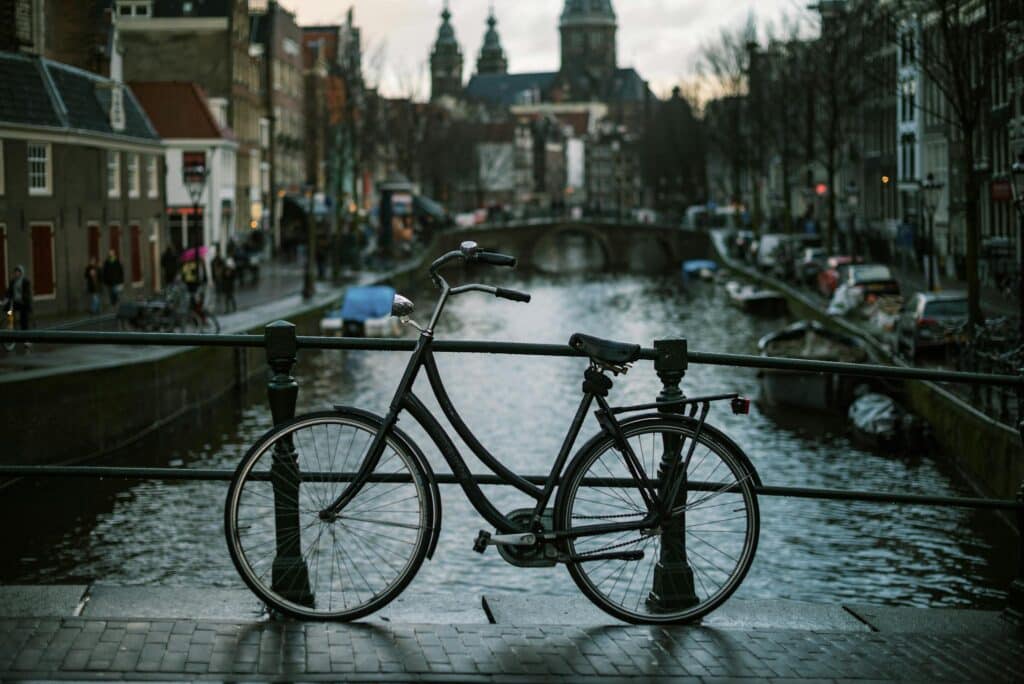
Time of day was another variable I slowly adjusted. After mastering weekend mornings, I ventured out during midday, then early evenings, and eventually worked up to actual rush hour. The progression was natural and never felt overwhelming because I’d built such a solid foundation of skills and confidence.
The most surprising thing about this journey was how quickly my perception shifted. Streets that had initially seemed terrifying became routine. Interactions with traffic that once spiked my anxiety became second nature. The transformation wasn’t because the streets changed – it was because I had changed, growing more skilled and confident with each ride.
I still remember the moment I realized I’d become a “real” urban cyclist. I was navigating a complex intersection during moderate traffic, and it suddenly hit me that I wasn’t scared at all. My hands weren’t clenched in a death grip on the handlebars. I was just… riding. That feeling of belonging in the urban landscape, of having every right to be there alongside other vehicles, was incredibly empowering.
What’s your biggest concern about city cycling? Whatever it is, I promise there’s a gradual path to overcoming it. Start small, celebrate your progress, and before you know it, you’ll be wondering why you ever thought it was intimidating in the first place.
Essential Tips for Success
My cycling journey started in complete chaos. I figured buying a bike meant I could instantly navigate busy streets like I’d been doing it for years. Boy, was I wrong! After a terrifying first ride that had me practically diving into bushes to avoid traffic, I realized I needed a smarter approach if I was going to stick with this cycling thing.
Starting with quiet residential streets completely changed my experience. I mapped out routes through neighborhoods where I rarely saw more than a car or two at a time. No pressure, no white-knuckle moments—just me getting comfortable with being on two wheels again. Those peaceful early morning weekend rides built my handling skills and confidence without the stress of traffic.
The best decision I ever made was joining a local cycling group’s “newbie ride.” I was hesitant—wouldn’t I hold everyone back? Turns out, these groups typically offer rides specifically designed for beginners. The experienced cyclists shared invaluable street wisdom that I couldn’t have gotten from any book or video. They showed me exactly where to position myself at tricky intersections and how to communicate effectively with drivers.

They also introduced me to the city’s hidden network of bike-friendly routes I never would have found on my own. These community connections transformed my riding experience from isolated and intimidating to social and supported. Even now, years later, I learn something new on almost every group ride.
Lighting was something I initially underestimated. My first setup was a dim little blinking light that probably wasn’t visible beyond twenty feet. After a close call at dusk, I finally invested in quality front and rear lights. The difference was immediate—cars began giving me noticeably more space, especially during early morning or evening rides. Adding reflective ankle bands and a vest made me even more visible. This relatively small investment dramatically increased my safety margin.
I used to panic at every unusual sound my bike made. Is that squeaking normal? Why is shifting suddenly difficult? The constant worry detracted from my enjoyment until I took a basic maintenance workshop at my local bike shop. Learning to clean and lube my chain, adjust my brakes, and fix a flat tire gave me incredible peace of mind. Now I can handle most common issues that pop up, which means I’m never stranded and my bike always performs reliably.
Weather adaptation took me longest to master. I started as a strictly fair-weather cyclist, but that severely limited my riding days. Gradually, I built up the right gear and mindset for different conditions. A good rain jacket and fenders made wet rides surprisingly manageable. Proper layering techniques kept me comfortable in colder temperatures. Now I ride year-round and actually enjoy the different seasonal experiences.
The most valuable tip I received was to be patient with myself. Some days you’ll feel like a cycling superhero, flowing through traffic with grace. Other days you might feel clumsy and uncertain. Both experiences are normal parts of the journey. Each ride adds to your skill bank, even the challenging ones—especially the challenging ones.
What cycling tips have made the biggest difference in your experience? Everyone’s journey is different, but these fundamentals have helped countless new riders move from anxious beginners to confident daily cyclists. The beautiful thing about cycling is that the learning curve feels steep at first, but progress comes surprisingly quickly with consistent practice.
Infrastructure Navigation
My first day commuting by bike was a comedy of errors. I stuck to main roads because, well, that’s how I drove to work! Made perfect sense, right? By the time I arrived, I was a sweaty, frazzled mess after battling rush hour traffic on busy thoroughfares. That evening, a coworker took one look at my route and just shook her head. “You’re doing it all wrong,” she told me. “There’s a whole network of bike infrastructure you’re completely missing.”
She wasn’t kidding. The next day, she showed me an entirely different way to get to work using dedicated bike lanes, shared paths through parks, and quiet neighborhood streets specifically designated as bike routes. The ride was not only less stressful but actually shorter! I couldn’t believe I’d been making my life so much harder unnecessarily.
That experience taught me my first big lesson about city cycling: understanding and utilizing the existing bike infrastructure completely transforms the urban riding experience. Many cities have invested in creating safer spaces for cyclists, but they’re not always obvious if you don’t know where to look.
Dedicated bike lanes come in several varieties, and knowing the differences matters for your safety and comfort. The gold standard is protected bike lanes with physical barriers separating you from traffic. I discovered a route with these on my east-side commute, and it feels like riding in a completely different city compared to sharing space with cars. Even painted bike lanes provide designated space that most drivers respect, though you’ll need to stay alert for parked cars and turning vehicles.
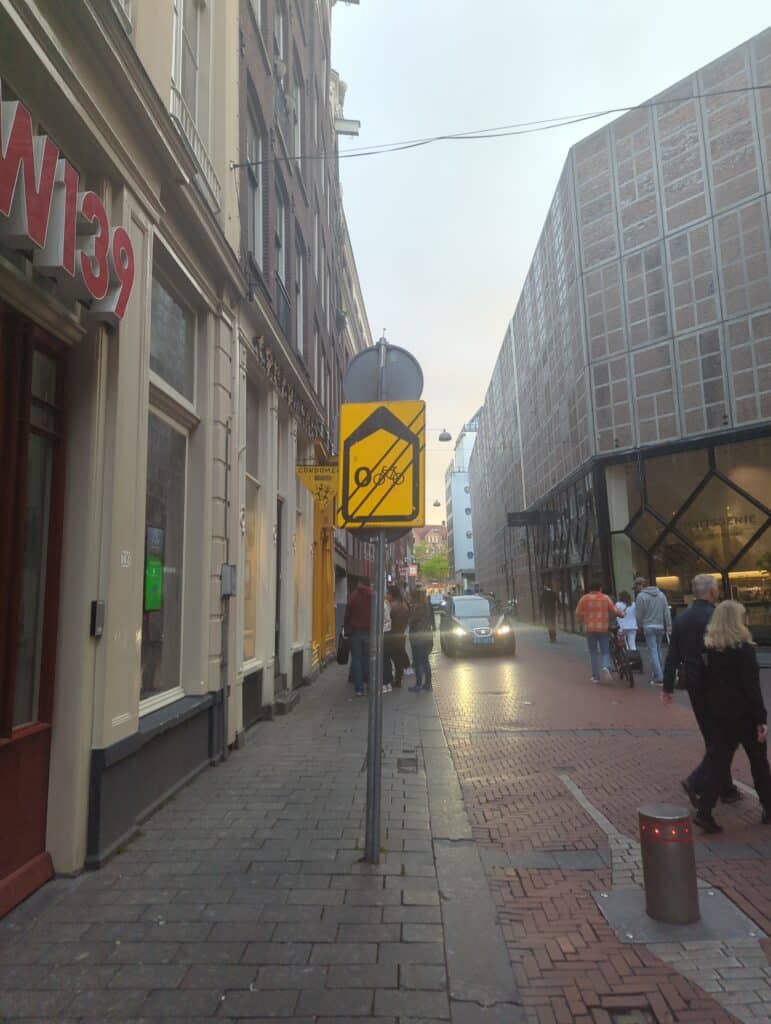
Shared paths and green ways became my secret weapon for pleasant commuting. These traffic-free routes often follow old railway lines, waterways, or cut through parks. They completely eliminate car interactions for significant stretches of your journey. The first time I rode our city’s riverfront green way, I couldn’t believe I’d been battling main street traffic when this peaceful alternative existed just two blocks away.
Contraflow bike lanes blew my mind when I discovered them. These allow cyclists to ride in both directions on otherwise one-way streets. They’ve become strategic shortcuts in my daily routes, cutting significant distance off my commute by letting me bypass complex one-way systems designed for cars. Finding these little infrastructure hacks has become something of a treasure hunt for me.
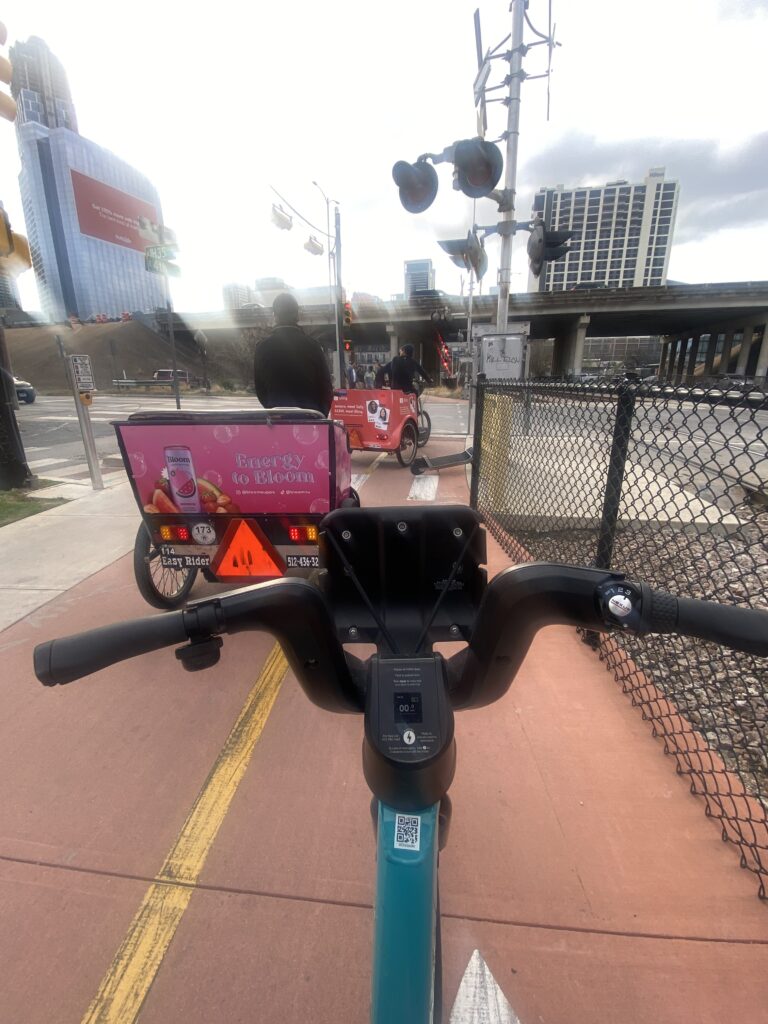
Bicycle boulevards (sometimes called neighborhood green ways) were a game-changer for my confidence. These are residential streets optimized for bike travel with traffic calming features that discourage cars from using them as shortcuts. They typically have lower speed limits, speed bumps, and sometimes even barriers that allow bikes to pass through while preventing cars from using them as through routes. These streets usually have clear signage or bike symbols painted on the pavement.
Learning to read the subtle clues of bike infrastructure took time. I started noticing bicycle crossing signals at intersections, bike-specific traffic signs, and even special bike waiting areas (bike boxes) at stoplights. Each discovery made navigating the city easier and more intuitive.
Cycling apps with infrastructure maps revolutionized my route planning. Regular mapping apps often miss bike-specific infrastructure, but specialized cycling apps show all the dedicated lanes, paths, and bike-friendly routes. They’ve helped me discover connections between bike lanes that aren’t obvious from just looking at a standard map.
The confidence boost from using proper infrastructure can’t be overstated. When I first started cycling, busy streets with no bike lanes would spike my anxiety to unbearable levels. Using dedicated infrastructure gave me space to develop my skills and confidence in a relatively protected environment. Now I can handle those busy streets when necessary, but I still prefer the dedicated routes when available.
Most surprising to me was discovering how infrastructure creates community. I regularly see the same faces on popular bike routes, and we exchange nods or brief chats at red lights. That sense of belonging to a community of everyday cyclists who understand the joys and challenges of urban riding has been an unexpected benefit of discovering my city’s bike network.
Has your city invested in cycling infrastructure? Take some time to explore what’s available – you might be surprised to find how much easier and more enjoyable your rides can become when you tap into the full network of cycling-specific routes and facilities. Even cities with minimal infrastructure usually have some hidden gems waiting to be discovered by observant cyclists.
Bike Security Strategies
I learned about bike security the hard way. After saving for months to buy my first decent commuter bike, I left it locked outside a coffee shop with what I thought was a “good enough” cable lock. Forty-five minutes later, I walked out to find nothing but a snipped cable on the ground. Talk about a gut punch! That $30 lock decision ended up costing me an $800 bike and weeks of frustration.
That painful experience transformed me into something of a bike security evangelist. Friends joke that I’m paranoid, but after five years without another theft, I’d say I’m just properly cautious. The truth is, with some straightforward security habits, you can dramatically reduce your chances of becoming another bike theft statistic.
The lock situation is where most cyclists go wrong initially. I certainly did! Cable locks are essentially just theft invitations – a decent pair of bolt cutters can snip through them in seconds. After my theft, I invested in a proper U-lock with a security rating. These hardened steel locks require power tools and significant time to defeat, which is exactly what thieves try to avoid.

For daily security, I follow what cyclists call the “3-10 rule” – spend at least 10% of your bike’s value on locks. For my current $1200 commuter, that means about $120 worth of security divided between a primary U-lock and a secondary chain lock. The two different lock types mean a thief needs multiple tools and twice the time commitment. Most will just move on to easier targets.
Location choice makes a massive difference in theft prevention. I now park in well-lit, high-visibility areas whenever possible. Thieves hate attention, so spots with regular pedestrian traffic or security cameras offer natural protection. I’ve passed up convenient rack locations for slightly farther ones with better visibility countless times. Those extra few steps are worth the peace of mind.
The actual locking technique matters more than I initially realized. After my theft, I learned about the proper way to secure a bike – lock the frame and rear wheel to the rack with your U-lock, then use a secondary lock for the front wheel. This secures the most valuable and easily removable parts. I used to just lock the frame, leaving my wheels vulnerable to quick-release theft.
Bike registration seemed like unnecessary paperwork until a coworker actually recovered his stolen bike through a registration system. Most cities now have online registration programs that create a documented connection between you and your bike’s serial number. I’ve registered mine with both the local police database and national registration services like Bike Index. If my bike ever does get stolen, this significantly increases recovery chances.
Quick-release components are convenient but problematic from a security perspective. After losing a seat to theft (yes, people steal those too!), I replaced my quick-release skewers with security skewers that require a special tool to remove. This small upgrade has prevented opportunistic parts theft while only adding a few seconds to maintenance when I actually need to remove a wheel.
For overnight storage, I never leave my bike outside if I can help it. Even the best locks can be defeated given enough time. I keep my bike in my apartment, hung on wall-mounted hooks to save space. For those without indoor options, some cities now offer secure bike lockers or bike parking rooms that provide much better protection than street parking.
The daily mental load of managing bike security gets easier with practice. What initially felt like an annoying security checklist – locking, removing accessories, choosing locations carefully – now happens automatically. It’s just part of my routine, like putting on a helmet or checking tire pressure.
What surprised me most about bike security is how the habits protect not just against theft but also from the constant worry about theft. The peace of mind that comes from knowing you’ve done everything reasonable to protect your bike makes urban cycling much more enjoyable. I can focus on the ride itself rather than stressing about whether my bike will still be there when I return.
Have you established your bike security routine yet? What’s been working for you? Remember that perfect security doesn’t exist, but with quality locks, smart habits, and proper technique, you can make your bike significantly less attractive to potential thieves. That’s really the name of the game – being more secure than the bike parked next to yours!
Weather-Proofing Your Ride
The day I got caught in an unexpected downpour without any rain gear was the day I finally took weather-proofing seriously. I arrived at work looking like I’d jumped fully clothed into a swimming pool, with squeaky shoes that left puddles under my desk all morning. My phone was water-damaged, my notebook ruined, and my dignity completely soaked through. Never again, I promised myself.
That embarrassing experience kicked off my journey to master the art of all-weather cycling. What I’ve discovered since is that with some strategic gear choices and simple bike modifications, there’s almost no weather that can stop you from riding comfortably. The freedom of year-round cycling has completely transformed my relationship with my bike.
Rain used to be my biggest cycling nemesis. Now? It’s barely an inconvenience. The game-changer was installing full fenders on my commuter bike. Before fenders, I’d end up with that classic dirty water stripe up my back every time I rode through a puddle. These $40 plastic shields keep road spray contained, meaning I arrive with just the rain that falls from above to contend with, not the filthy water from the road.
Waterproof panniers were my next revelation. I started with a standard backpack covered by a rain cover, but water would eventually seep through during heavy downpours. Switching to proper waterproof panniers meant my laptop, clothes, and lunch stayed bone dry even during the worst storms. They’re essentially like having portable dry bags attached to your bike.
My rain gear strategy evolved through painful trial and error. I initially went for the cheapest rain jacket I could find, only to discover I’d arrive at my destination dry from rain but completely soaked with sweat because the jacket didn’t breathe at all. The solution wasn’t necessarily expensive cycling-specific gear, but rather understanding layering. A good waterproof-breathable outer layer combined with moisture-wicking base layers keeps me dry from both outside precipitation and inside perspiration.
Cold weather riding intimidated me until I figured out the right approach. The mistake most new winter cyclists make is overdressing and overheating. I learned to start rides feeling slightly chilly, knowing I’d warm up within the first mile. My hands and feet need the most protection, so good gloves and wool socks became my winter essentials. For truly frigid days, chemical toe warmers inside my shoes work wonders.
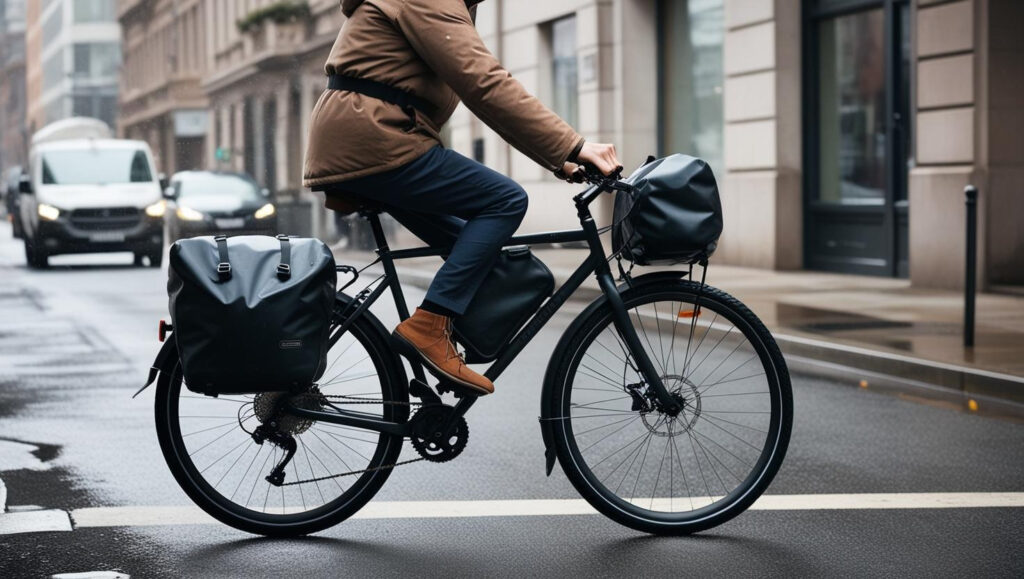
Face protection was something I overlooked until experiencing the unique pain of freezing rain pelting my cheeks during a January commute. A simple neck gaiter that can be pulled up over the lower half of my face transformed winter riding comfort. Being able to breathe through a thin layer takes the sharp edge off the cold air without feeling restrictive.
Hot weather presented its own challenges. I discovered the hard was that sunburn can happen even on cloudy days during a long ride. Now I apply sunscreen religiously from spring through fall. For scorching days, switching to a breathable helmet with good ventilation made a surprising difference in overall comfort. Pre-cooling by soaking a bandana in cold water and wearing it around my neck helps manage my core temperature on the hottest days.
Carrying seasonal extras became part of my routine. In summer, I keep a small towel and deodorant in my bag for a quick freshen-up upon arrival. During transition seasons with unpredictable weather, I always pack a lightweight rain jacket that stuffs into a tiny pouch. Winter rides mean carrying an extra pair of dry socks in case of unexpected puddle mishaps.
The mental shift was perhaps the biggest weather-proofing breakthrough. I used to see rain as a reason not to ride. Now I view it as simply a different riding experience that requires different gear. That perspective change, more than any specific equipment, transformed me from a fair-weather cyclist to an all-season rider.
My favorite discovery has been how seasonal riding connects you more deeply to the changing rhythms of the year. There’s something magical about riding the same route through spring blossoms, summer heat, autumn colors, and winter stillness. That connection to the seasons is something car commuters rarely experience from inside their climate-controlled bubbles.
What weather conditions have been keeping you off your bike? With the right preparation, you might find those challenging days become some of your most memorable rides. The satisfaction of conquering elements that once seemed insurmountable brings its own special joy to cycling. Plus, you’ll earn some serious respect from both cyclists and non-cyclists alike when you roll up on a day everyone else opted to drive!
Community Resources
I still remember how isolated I felt during my first month of city cycling. Every challenge seemed like something I alone was struggling with, and I had no idea where to turn for guidance. Was I the only one terrified of left turns? Did everyone else magically know how to fix a slipped chain? That all changed when I reluctantly attended a “Beginner-Friendly Social Ride” advertised at my local bike shop. Talk about a game-changer!
What I discovered that day was that an entire support network existed right under my nose. Seasoned cyclists were not only willing but actually eager to share their knowledge with newcomers like me. That single afternoon ride connected me with resources that accelerated my cycling journey far beyond what I could have achieved on my own.
Local bike shops are often the hub of cycling communities, but I initially viewed them only as places to buy gear. Big mistake! Most shops host regular maintenance clinics, group rides, and informal hangouts where knowledge flows freely. The mechanic who taught me to adjust my brakes during a free workshop has saved me countless dollars in service fees—and more importantly, empowered me to handle roadside fixes confidently.
Online neighborhood groups dedicated to cycling were another revelation. Through these virtual communities, I found route recommendations specific to my exact neighborhood, warnings about construction hazards, and even a “bike buddy” program that paired experienced commuters with newcomers sharing similar routes. The local insights these groups provide simply can’t be found on any app or website.
Group rides completely transformed my confidence level. Starting with beginner-focused events with supportive leaders, I learned proper road positioning, signaling techniques, and traffic navigation through direct experience rather than theory. Seeing others navigate challenging intersections ahead of me provided a real-time demonstration that no YouTube video could match.
Bike advocacy organizations in my city offered workshops specifically focused on urban riding skills. These structured sessions covered everything from emergency maneuvers to traffic law specifics. The confidence I gained from practicing quick stops and evasive turns in a controlled environment transferred directly to my daily rides. Most of these resources were either free or very low-cost, made possible through volunteer efforts.
Mentorship opportunities emerged organically once I became a regular at community events. An experienced commuter who shared part of my route offered to ride with me for a week, providing real-time coaching on specific trouble spots. Those five morning commutes with her guidance were more valuable than months of solo trial and error. Now I do the same for others, paying forward the knowledge that was so freely shared with me.
Community bike workshops became my secret weapon for maintenance skills. These volunteer-run spaces provide tools, parts, and knowledgeable helpers who teach you to work on your own bike rather than doing it for you. The satisfaction of fixing my first flat tire with guidance rather than panicked YouTube searches was immeasurable. Plus, these spaces often offer seriously discounted used parts that have saved me hundreds over the years.
The most unexpected community resource came from my workplace. After mentioning my cycling commute in a team meeting, I discovered several colleagues who also rode. This led to the creation of an informal bike-to-work group that shares routes, weather updates, and occasionally meets for group commutes. Having this built-in support network at my destination made the entire commuting experience feel more feasible and less daunting.
Cultural cycling events opened doors to diverse riding communities I might never have connected with otherwise. From historical neighborhood tours on wheels to food-focused rides stopping at local restaurants, these events showed me that cycling culture extends far beyond spandex-clad road warriors. Finding the specific subcommunity that resonated with my interests made cycling feel less like transportation and more like a lifestyle I genuinely enjoyed.
The knowledge sharing within these communities saved me from countless mistakes. When I mentioned plans to leave my new bike locked up overnight downtown, several experienced riders gently steered me toward better security practices. Their collective wisdom, earned through years of trial and error (and yes, some stolen bikes), helped me avoid learning these lessons the hard way.
Has your local cycling community surprised you with its resources? Or are you still riding solo, unaware of the support network that might exist around you? Reaching out to these communities might feel intimidating at first, but I’ve found cyclists to be universally excited about welcoming newcomers. After all, every confident cyclist on the road today was once a nervous beginner looking for guidance.
Closing Thoughts
While urban cycling challenges may seem significant at first, they’re far from insurmountable. With proper preparation, knowledge, and a positive mindset, these obstacles transform into manageable parts of your daily routine. The rewards of urban cycling – including improved health, reduced stress, and environmental benefits – far outweigh the initial learning curve.
Remember that even I started as a beginner, as a kid I had one of those huffy bikes everybody hates. Still I had to start there and use what I had to get around, usually to my local Walgreens a mile away. Create your journey by getting out there in whatever environment your in to get around, and there’s other apps that will help you with it.
